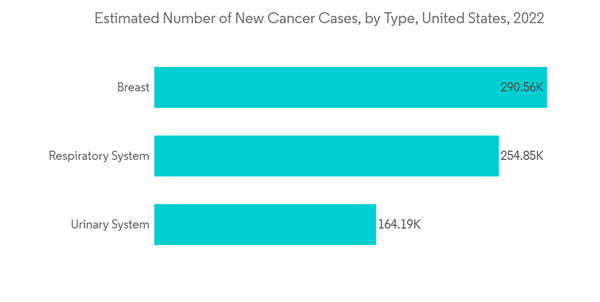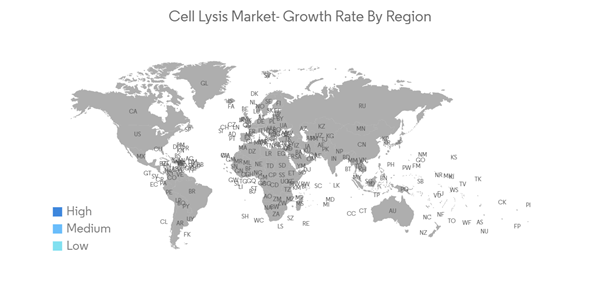The cell lysis market is expected to register a CAGR of 8.5% over the forecast period.
Severe respiratory consequences of the COVID-19 pandemic prompted an urgent need for novel therapies that increased the number of drug discoveries, thereby positively impacting the cell lysis market. Several research studies were conducted to understand the effect of cell lysis on coronavirus. For instance, during the peak of the COVID-19 pandemic, the Department of Biotechnology (DBT) in India undertook a project to sequence 1,000 SARS-CoV-2 genomes from samples to understand the evolving behavior of the virus. The samples were collected across India to study the emerging mutations in the virus and how they change the symptoms of the disease. The increase in research activities that used different processes increased the demand for cell lysis devices and reagents.
The market is expected to grow due to increased expenditure on research and development, increasing application in the pharmaceutical and biopharmaceutical industries, and a rising focus on personalized medicine. Personalized medicine is one of the latest developments of gene-related studies that provide custom-tailored treatments as per the specific needs of patients, which has massive significance in disease prevention, diagnosis, prognosis, and therapeutics. According to the GLOBOCAN, in 2020, there were around 19,292,789 new cancer cases worldwide and about 9,958,133 deaths due to cancer. With the increase in the prevalence of infectious diseases and cancers, the use of cell samples for research and development of drugs also increases, which is expected to support the growth of the cell lysis market.
The high adoption of cell lysis and disruption methods during downstream processing to manufacture bio-therapeutics and other recombinant products further boosts the overall market growth. Furthermore, rising investments by governments and private organizations in R&D related to biotechnological processes and academics are expected to drive the market significantly. However, regulatory compliance and issues in the mechanical process in applying at the microscale level are some factors that might hinder market growth.
Recent advancements in cell lysis allowed the emergence of microfluidic devices in the cell lysis process. For instance, as per a study published by a Biotechnology Journal in April 2022, microfluidic technology is widely used for cell lysis. Separation and lysis of RBCs are helpful in the diagnosis of several diseases, which augments the demand for microfluidics in cell lysis, thus contributing to market growth.
With the rising number of chronic diseases and infectious diseases, there is a high demand in research laboratories and institutes and biopharmaceutical and biotechnology companies, which boosted the overall drug demand. For instance, as per the data from the American Cancer Society report published in 2022, around 1,918,030 new cancer cases were expected in the United States in 2022. This high number of cancer cases indicates the need for research and diagnosis of the disease, which is expected to propel the growth of the segment . The commercial availability and reliability of tools used in cell disruption and lysis also boost the growth of this segment.
The increasing demand for cell-based therapies for the treatment of cancer is also expected to augment the growth of the cell lysis market. The increasing prevalence and incidence of several diseases and rising research and development expenditure in North America trigger the need for an advanced research and development scenario across all life sciences sectors. According to the Pharmaceutical Research and Manufacturers Association (PhRMA), in 2021, US companies conducted over half the world's research and development in pharmaceuticals. The same source stated that approximately USD 102 billion was invested in biopharmaceutical R&D in the United States in 2021.
Hence, the continuous growth of healthcare infrastructure in the United States and the increase in the patient population provide wider opportunities for clinical laboratories to expand and help boost market growth.
This product will be delivered within 2 business days.
Severe respiratory consequences of the COVID-19 pandemic prompted an urgent need for novel therapies that increased the number of drug discoveries, thereby positively impacting the cell lysis market. Several research studies were conducted to understand the effect of cell lysis on coronavirus. For instance, during the peak of the COVID-19 pandemic, the Department of Biotechnology (DBT) in India undertook a project to sequence 1,000 SARS-CoV-2 genomes from samples to understand the evolving behavior of the virus. The samples were collected across India to study the emerging mutations in the virus and how they change the symptoms of the disease. The increase in research activities that used different processes increased the demand for cell lysis devices and reagents.
The market is expected to grow due to increased expenditure on research and development, increasing application in the pharmaceutical and biopharmaceutical industries, and a rising focus on personalized medicine. Personalized medicine is one of the latest developments of gene-related studies that provide custom-tailored treatments as per the specific needs of patients, which has massive significance in disease prevention, diagnosis, prognosis, and therapeutics. According to the GLOBOCAN, in 2020, there were around 19,292,789 new cancer cases worldwide and about 9,958,133 deaths due to cancer. With the increase in the prevalence of infectious diseases and cancers, the use of cell samples for research and development of drugs also increases, which is expected to support the growth of the cell lysis market.
The high adoption of cell lysis and disruption methods during downstream processing to manufacture bio-therapeutics and other recombinant products further boosts the overall market growth. Furthermore, rising investments by governments and private organizations in R&D related to biotechnological processes and academics are expected to drive the market significantly. However, regulatory compliance and issues in the mechanical process in applying at the microscale level are some factors that might hinder market growth.
Cell Lysis Market Trends
Instruments are Expected to Witness Significant Growth in the Coming Years
Instruments are tools or devices used to lyse the cells. They are further categorized as sonicators, homogenizers, French press, microfluidizers, and others. Instruments like homogenizers and sonicators are used mostly for cell lysis/cell fractionation, and sonicators have the highest demand due to their increasing use in cell fractionation.Recent advancements in cell lysis allowed the emergence of microfluidic devices in the cell lysis process. For instance, as per a study published by a Biotechnology Journal in April 2022, microfluidic technology is widely used for cell lysis. Separation and lysis of RBCs are helpful in the diagnosis of several diseases, which augments the demand for microfluidics in cell lysis, thus contributing to market growth.
With the rising number of chronic diseases and infectious diseases, there is a high demand in research laboratories and institutes and biopharmaceutical and biotechnology companies, which boosted the overall drug demand. For instance, as per the data from the American Cancer Society report published in 2022, around 1,918,030 new cancer cases were expected in the United States in 2022. This high number of cancer cases indicates the need for research and diagnosis of the disease, which is expected to propel the growth of the segment . The commercial availability and reliability of tools used in cell disruption and lysis also boost the growth of this segment.
North America is Expected to Dominate the Market Over the Forecast Period
North America is spearheading the cell lysis market due to the increasing expenditure on research and development and increasing incidence of chronic diseases. With the rise in COVID-19, there was an increase in lab testing techniques, which was anticipated to intensify the progress of the cell lysis market. Furthermore, scientists researching COVID-19 cellular response and developing vaccines created a huge demand for cell lysis systems and reagents. Thus, increasing research in the region had a positive impact on the market.The increasing demand for cell-based therapies for the treatment of cancer is also expected to augment the growth of the cell lysis market. The increasing prevalence and incidence of several diseases and rising research and development expenditure in North America trigger the need for an advanced research and development scenario across all life sciences sectors. According to the Pharmaceutical Research and Manufacturers Association (PhRMA), in 2021, US companies conducted over half the world's research and development in pharmaceuticals. The same source stated that approximately USD 102 billion was invested in biopharmaceutical R&D in the United States in 2021.
Hence, the continuous growth of healthcare infrastructure in the United States and the increase in the patient population provide wider opportunities for clinical laboratories to expand and help boost market growth.
Cell Lysis Market Competitor Analysis
The market studied is moderately competitive and consists of local and international companies. Some players include Thermo Fisher Scientific Inc., Merck KGaA, F. Hoffmann-La Roche Ltd, Qiagen NV, Becton, and Dickinson and Company, among others. These companies focus on novel product developments and acquisitions/collaborations to enhance their market positions. With advancements in the pharmaceutical and biotechnology sector, few small to mid-sized companies have entered the market. It is believed that these companies will hold a substantial share of the market studied in the future. Competition is also increasing due to new product launches in this market.Additional benefits of purchasing the report:
- The market estimate (ME) sheet in Excel format
- 3 months of analyst support
This product will be delivered within 2 business days.
Table of Contents
1 INTRODUCTION
4 MARKET DYNAMICS
5 MARKET SEGMENTATION (Market Size - Value in USD million)
6 COMPETITIVE LANDSCAPE
Companies Mentioned (Partial List)
A selection of companies mentioned in this report includes, but is not limited to:
- Becton, Dickinson and Company
- Bio-Rad Laboratories Inc.
- Danaher Corporation
- Eppendorf AG
- F. Hoffmann-La Roche Ltd
- Labfreez Instruments Group Co. Ltd
- Merck KGaA
- Qsonica LLC
- Takara Bio Inc.
- Thermo Fisher Scientific Inc.
- Cell Signaling Technology Inc.
- Miltenyi Biotec
- QIAGEN NV
- Claremont BioSolutions LLC
- Microfluidics International Corporation
Methodology

LOADING...










